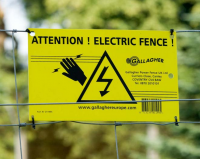








An electric fence is a barrier that uses electric shocks to deter animals or people from crossing a boundary. The voltage of the shock may have effects ranging from discomfort to death. Most electric fences are used today for agricultural fencing and other forms of animal control, although it is frequently used to enhance the security of sensitive areas, such as military installations, prisons, and other security sensitive places; places exist where lethal voltages are used.
An early application of the electric fence was developed in 1936–1937 by New Zealand inventor William “Bill” Gallagher Sr. Built from a car’s ignition coil and a magneto set, Gallagher used the device to keep his horse from scratching itself against his car. Gallagher later started a company to improve and market the design.
In 1962, another New Zealand inventor, Doug Phillips, invented the non-shortable electric fence based on capacitor discharge. This significantly increased the range an electric fence could be used from a few hundred meters to 35 km (~20 miles), and reduced the cost of fencing by more than 80%. The non-shortable electric fence was patented by Phillips and by 1964 was manufactured by Plastic Products, a New Zealand firm, under the name “Waikato Electric Fence.” This idea was to replace ceramic with plastic insulators. A variety of plastic insulators are now used on farms throughout the world today.
By 1939, public safety concerns in the United States prompted Underwriters’ Laboratories to publish a bulletin on electric shock from electric fences, leading to the ANSI/UL standard No. 69 for electric fence controllers.
In 1969 Robert B. Cox, a farmer in Adams County, Iowa, invented an improved electric fence bracket and was issued United States Patent No. 3,516,643 on June 23, 1970. This bracket improved electric fences by keeping the wire high enough above the ground and far enough away from the fence to permit grass and weeds growing beneath the wire to be mowed. The brackets attached to the posts by what may be called a “pivot bind” or “torsion-lock.” The weight of the bracket, the attached insulator and the electric wire attached to the insulator bind the bracket to the post.